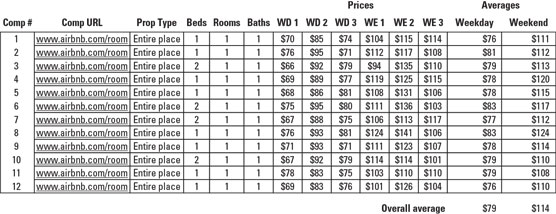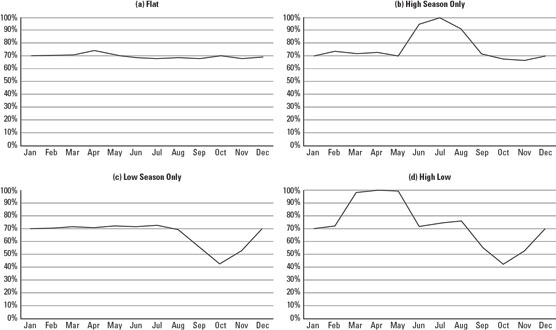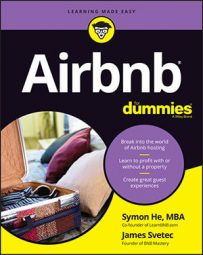To establish the baseline pricing, you analyze comparable listings on Airbnb to create a pricing strategy that works for you. The following sections help you start pricing your listing so it’s competitive wherever you live.
Study your competition: Gather comparable market data
The best way to establish your baseline pricing is by looking at what your competition is charging in your market. You can think of your market as the tightest geographic radius that allows you to gather data for at least a dozen comparable and competitive listings. For example, in an ultrahigh-density urban market, this could be just a one block or even a minute walking radius. In the sparse country side, it could mean more than 10 miles or a 30-minute drive radius. In a typical suburban neighborhood, a safe starting point is three blocks or a 15-minute walking radius. You’ll need to adjust as needed for your specific area.Your competition includes the most similar Airbnb listings in your market — those similar in size (beds, bedrooms, bathrooms), amenities, and overall positioning in terms of pricing and target audience. For example, if your Airbnb listing is a one-bedroom unit targeting the budget-friendly traveler who doesn’t mind being a bit farther out from the main attractions, then your competition is similar, economy-focused one-bedroom Airbnb listings. However, if your Airbnb listing is a two-bedroom luxury condominium in a downtown luxury high-rise residence, your competition includes other two-bedroom luxury Airbnb listings.
When studying the competition, gather at least a six (preferable a dozen or more) similar Airbnb listings and record the following information:- Weekday rates: For each comparable Airbnb listing and hotel listing, collect the average weekday rates (Sundays to Thursdays) for four weeks, eight weeks, and 12 weeks into the future. Take the average of those five days for each of the three weeks for each comparable listing.
- Weekend rates: For each comparable Airbnb listing and hotel listing, collect the average weekend rates (Fridays and Saturdays only) for four weeks, eight weeks, and 12 weeks into the future. Take the average of those two days for each of the three weeks for each comparable listing.
If you’re unable to find enough (at least six) comparable Airbnb listings in your market for your baseline pricing analysis, you can substitute with comparable hotel listings. For most Airbnb hosts, comparing to economy and midrange hotel offerings make the most sense. Identify the nearest two- and three-star hotels to your property and compare your studio or one-bedroom listing to their lowest priced offering. For larger properties of two- or three-bedrooms, compare to the lowest priced hotel suites. However, you may need to adjust your findings down by 15 to 30 percent because average hotel listings are often priced higher than their Airbnb counterparts in the same market.
When you’re done collecting this information, you’ll have six data points for each of the listings you’ve identified for your comparison — three weekday averages and three weekend averages — resulting from 21 daily prices for each of the comps.Taking the average again of the average weekday and weekend rates for these similar listings gives you a good baseline pricing for your Airbnb listing in your market. The following figure shows an example with 12 comparable Airbnb listings and their corresponding data points for their weekday and weekend pricing.
 Baseline pricing exercise
Baseline pricing exerciseTracking additional information for the comparable listings can help you understand the pricing dynamic in your market even better. Tracking additional information such as the listing URLs, property type, number of bedrooms, number of bedrooms, and number of bathrooms can assist you to fine-tune your baseline pricing analysis.
Choose a baseline pricing strategy
After you gather your data and have a baseline weekday and weekend pricing rate that you feel comfortable with, you need to figure out how to use that information. Here are three primary pricing strategies you can consider adopting to price your listing:- Match market offering and charge less. If you intend to match the amenities and overall offering of your competition, you can gain an edge by charging slightly less than your competition. By offering the same amenities at a discount, you’ll be able to secure more bookings.
- Beat market offering and charge the same. If you intend to clearly beat the offering of your competition, you can gain an edge by charging the same overall pricing as your competition. By offering better amenities at the same price, you’ll also be able to secure more bookings.
- Make unique offering and charge premium. If your Airbnb listing offers something unique that guests value and the competition in your market can’t match, then you may be able to charge a premium. By offering something unique and valuable, you’ll be able to charge more than your competition.
However, settling on your baseline pricing doesn’t mean you just set your pricing to these levels for the entire availability of your listing. At various times you want to purposely price lower or higher than your baseline pricing. We explore each of moments in the following discussions.
Ramping Up to Baseline Pricing
The first such scenario where you price differently from your baseline pricing is during your ramping-up period, typically the first two to four months after an Airbnb listing first goes live on the platform. During these first months on the platform, your objective is to build momentum for your listing as quickly as possible, not to maximize the profits of any individual bookings.To do so, get as many bookings and as many 5-star guest reviews as fast as possible. When a listing is fresh on the platform, it has no bookings and no reviews. All things equal, potential guests almost always book with listings that have more reviews than similar listings with no reviews.
During your ramping-up period, follow this pricing schedule to build momentum for your listing:- Start at 20 percent lower than your baseline pricing. Doing so underprices your listing relative to your competition right out of the gate.
- Wait for one week and check to see if your listing is mostly booked two weeks out.
- If mostly booked for the next two weeks, then stay the course until your listing is mostly booked four weeks out — aim for 80 percent plus occupancy.
- If not booked out, drop pricing by another 10 percent every week until you’re booked four weeks out.
- If more than four weeks are booked within the first week, then raise prices by 10 percent every week until you’re fully booked for the next four weeks or until reaching baseline pricing.
- After you reach the baseline pricing, sign up for third-party dynamic pricing software to monitor and adjust pricing going forward automatically.
Be sure to note in your listing profile title and description that your listing is “NEW.” Doing so can help potential guests get comfortable with your lack of reviews and help them understand why your listing is priced so favorably versus competition — that it’s due to your newness and not some defect.
Adjusting for seasonality
When setting your pricing, sometimes you need to adjust for seasonality. Seasonality means the overall Airbnb demand — the occupancy and average nightly rates for Airbnb listings in the market — may be much higher or lower than their typical rates when travel is correspondingly much higher or lower than average.For example, Airbnb cabins by a popular ski resort may be booked almost every evening, even at much higher than average nightly rates during the high demand skiing season. However, these same cabins may have a hard time booking nights even at significantly discounted rates during low season when the snow has melted and far fewer guests want to spend their hot summer on these dry barren ski slopes.
For some Airbnb markets with well-defined seasonal attractions, you can easily know whether there is seasonality in the market. But for many markets without obvious seasonal factors for travel demand, you can verify seasonality by obtaining the relevant market data for the prior 12 months (a full calendar year).
The seasonality of your Airbnb market falls into one of these four categories:
- Flat seasonality: If the demand is the same all year around, then there is flat seasonality. In these rare markets, you can expect the occupancy and average nightly rates to stay about the same throughout the year. Often, flat seasonality is associated with low overall Airbnb travel demand for the market.
- High season only: If the demand spikes high for a part of the year but stays flat the rest of the year, then the seasonality is said to have a high season. In these markets, you can expect the occupancy and average nightly rates to spike higher only during the high season but stay relatively flat the rest of the time.
- Low season only: If the demand drops lower for a part of the year but stays flat the rest of the year, then the seasonality is said to have a low season. In these markets, you can expect the occupancy and average nightly rates to fall noticeably lower only during the low season but stay relatively flat the rest of the time.
- High low seasons: If the demand drops lower for a part of the year and spikes higher for a different part of the year compared to a middle level the rest of the year, then the seasonality has both a high and low season. In these markets, you can expect occupancy and average night rates both to drop during low season and spike during high season.
 Different kinds of seasonality
Different kinds of seasonalityFig. A shows a flat seasonality market, Fig. B a high season only seasonality market, Fig. C a low season only seasonality market, and Fig. D a high and low seasonality market. For all examples, the average occupancy rate during normal season is at 70 percent.

